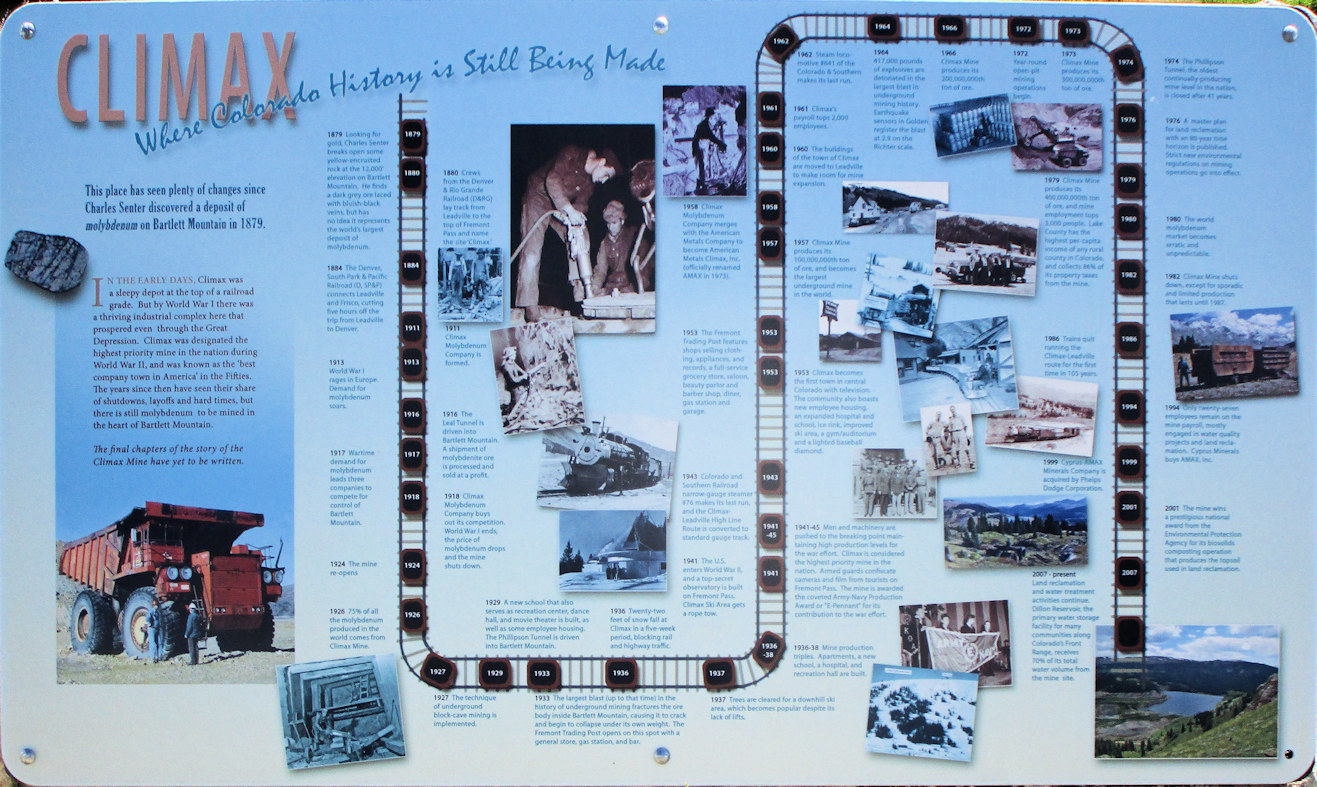|
1879
Looking for gold
Charles Senter breaks open some yellow-encrusted rock at 12,000'
elevation on Bartlett Mountain.
He finds a dark grey ore laced with bluish-black veins,
but has no idea it represents the world's largest deposit of
molybdenum.
1880
Crews from the Denver & Rio Grande Railroad (D&RG)
lay track from Leadville to the top of Fremont Pass
and name the site “Climax.”
1884
The Denver South Park & Pacific (DSP&P) connects Leadville
and Frisco, cutting five hours off the trip from Leadville to Denver.
1911
Climax Molybdenum Company is formed.
1913
World War I rages in Europe.
Demand for molybdenum soars.
1916
The Leal Tunnel is driven into Bartlett Mountain.
A shipment of molybdenite ore is processed and sold at a profit.
1917
Wartime demand for molybdenum leads three companies to compete
for control of Bartlett Mountain.
1918
Climax Molybdenum Company buys out its competition,
World War I ends,
the price of molybdenum drops and the mine shuts down.
1924
The mine re-opens.
1926
75% of all the molybdenum produced in the world
comes from Climax Mine.
1927
The technique of underground block-cave mining is implemented.
1929
A new school that also serves as recreation center, dance hall,
and movie theater is built,
as well as some employee housing.
The Phillipson Tunnel is driven into Bartlett Mountain.
1933
The largest blast (up to that time)
in the history of underground moning fractures the ore
body inside Bartlett Mountain,
causing it to crack and begin to collapse under its own weight.
The Fremont Trading Post opens on this spot with
a general store, gas station, and bar.
1936
Twenty-two feet of snow fall at Climax in a five-week period,
blocking rail and highway traffic.
1937
Trees are cleared for a down hill ski area,
which becomes popular despite its lack of lifts.
1936-38
Mine production triples.
Apartments, a new school, a hospital, and
recreation hall are built.
1941
The U. S. enters World War II,
and a top-secret observatory is built on Fremont Pass.
Climax Ski Area gets a rope tow.
1941-45
Men and machinery are pushed to the breaking point
maintaining high production levels for the war effort.
Climax is considered the highest priority mine in the nation.
Armed guards confiscate cameras and film from
tourists on Fremont Pass.
The mine is awarded the coveted Army-Navy Production Award
of “E-Pennant” for its contribution to the war effort.
1943
Colorado and Southern Railroad narrow-gauge steamer #76
makes its last run,
and the Climax-Leadville High Line Route is converted to standard
gauge track.
1953
Climax becomes the first town in central Colorado with television.
The community also boasts new employee housing,
an expanded hospital and school,
ice rink, improved ski area, a gym/auditorium,
and a lighted baseball diamond.
1953
The Fremont Trading Post features shops selling clothing,
appliances, and records,
a full-service grocery store, saloon, beauty parlor
and barber shop, diner, gas station and garage.
1957
Climax Mine produces its 100,000,000th ton of ore,
and becomes the largest underground mine in the world.
1958
Climax Molybdenum Company merges with
American Metals Company to become
American Metals Climax, Inc.
(Officially renamed AMAX in 1973).
1960
The buildings of the town of Climax are moved to Leadville
to make room for mine expansion.
1961
Climax's payrolls tops 2,000 employees.
1962
Steam locomotive #641 of the Colorado & Southern makes its last run.
1964
417,000 pounds of explosives are detonated in the largest
blast in underground mining history.
Earthquake sensors in Golden register the blast at 2.9 on the
Richter scale.
1966
Climax Mine produces its 200,000,000th ton of ore.
1972
Year-round open-pit mining operations begin.
1973
Climax mine produces its 300,000,000th ton of ore.
1974
The Phillipson Tunnel,
the oldest continually-producing mine level in the nation,
is closed after 41 years.
1976
A master plan for land reclamation with an 80-year time
horizon is published.
Strict new environmental regulations on mining operations
go into effect.
1979
Climax Mine produces its 400,000,000th ton of ore,
and mine employment tops 3,000 people.
Lake County has the highest per-capita income of any rural
county in Colorado,
and collects 86% of its property taxes from the mine.
1980
The world molybdenum market becomes erratic and unpredictable.
1982
Climax Mine shuts down,
except for sporadic and limited production that lasts until 1987.
1986
Trains quit running the Climax-Leadville route for the first time
in 105 years/
1994
Only twenty-seven employees remain in the mine payroll,
mostly engaged in water quality projects and land reclamation.
Cyprus Minerals buys AMAX, Inc.
1999
Cyprus-AMAX Minerals Company is acquired by Phelps Dodge Corporation.
2001
The mine wins a prestigious national award from the
Environmental Protection Agency
for its biosolids compisting operation
that produces the topsoil used in land reclamation.
2007 - present
Land reclamation and water treatment activities continue.
Dillon Reservoir,
the primary water storage facility for many communities
along Colorado's Front Range,
receives 70% of its total water volume from the mine site.
|  Eastern Mojave Vegetation
Eastern Mojave Vegetation
 Eastern Mojave Vegetation
Eastern Mojave Vegetation

